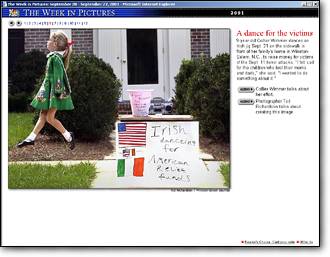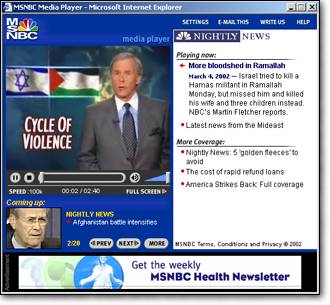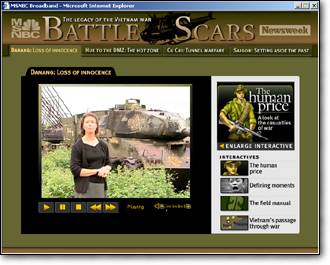|
Made
for the Medium: Photojournalism at MSNBC.com
by Brian Storm
Redmond, Wash. –
I can understand
how many working in photojournalism have negative feelings about the
state of our profession. Assignments are rare, pay abysmal, and contracts
are far reaching.
As a result, some of the best people in our profession don't stay long
because they can't make a living. Young, energetic and naïve photojournalists
spend the first few years of their careers learning the craft, honing
their skills for the privilege of beating their heads against what seems
to be an immovable legacy of disrespect. On top of the challenges facing
photojournalists, are the overall financial woes of journalism leading
to an industry-wide talent drain.
It's a vicious cycle that we MUST find a way to break.
I have a hard time remaining silent at a time when our profession seems
to be sliding off the edge. The decline is particularly frustrating
when a revolution in both storytelling and mass distribution in new
media are gaining momentum.
Although the economics of new media haven't caught up with its storytelling
capabilities yet, the coming of a transaction based Web will assign
cold cash against quality images.
The race to have the best content will be aggressive as those with the
best pictures will make the most transactions. Publications need to
have the integrity to share the fiscal prosperity which will allow photojournalists
to stop worrying about money and go back to making great pictures.
It's clear to me that the still image can survive in this whiz-bang
medium, but photojournalists have to work to extend their storytelling
capabilities.
For those willing to learn new storytelling tools, a viable and exciting
career in photojournalism is waiting.
Made
for the Medium Storytelling
At MSNBC.com we live in a unique world where TV, radio, print and
Web techniques work in tandem, often creating more depth than an individual
medium could alone.
The
MSNBC.com multimedia team aspires to make our users more than just readers
- we want them to be viewers, listeners, and participants. Quality photojournalism
is the bedrock on which we build those experiences, but we need to grow
beyond the single image to fully realize the possibilities of the Internet.
On some levels, MSNBC.com and other news sites have already moved past
newspaper and broadcast-style publishing. We tap sophisticated radio
conventions and will soon move into a high-end video world. Technological
advances on the Web will offer the best of all these media with full-frame
video, rich surround sound and huge photographs.
Our focus at MSNBC.com is now on playing to the strengths unique to
our medium by adding value to still images with in-depth captions and
tightly edited audio/video components. Our goal is to use new technology
so effectively that it fades into the background as the story is the
reader focus.
That said,
we don't need to reinvent the basic rules of great picture, audio or
video editing. We can -- and should -- leverage the core ideas from
traditional media.
National
Public Radio Meets Documentary Photojournalism
I often refer to audio that complements a photograph as a "caption
on steroids."
Gathering ambient sound and recording a subject's interpretation of
a story are the perfect complements to a documentary photograph. NPR
reports often paint a vivid picture of characters and their surroundings,
putting the listener on the scene and providing evocative context in
a style complementary to slice-of-life photojournalism.
How many times has a subject told you a story or provided a detail about
his or her life that you remembered in the picture-editing process?
Wouldn't it be powerful if you could share that experience with your
readers as well?
Investing in a mini disc recorder and microphone is probably the most
important thing a photojournalist can do to get into the new media game.
Instead of photojournalists TAKING a picture, we can GIVE our subjects
a voice.


|
In late 1996
Laura Kleinhenz and Michael Lutzky teamed up to document Australian
John Graham's battle with illness and his desire to end his life.
Kleinhenz covered the story in stills and Lutzky in video.
The audio track in this project, particularly slide 4, is a great
example of how sound can take a picture story to a new level.
Another example worth hearing is Amanda Otter in Allan Detrich's
Children
of the Underground package.
|
|
Unfortunately,
few photojournalists are thinking about gathering audio in the
field. Ideally sound comes from the actual event, but phone even
interviews can be effective. Listen
to 9-year-old Collier Wimmer explain in slide 6 how she decided
to help in the World Trade Center relief effort.
|


|
|
"Burns-style
video"
Video allows the MSNBC.com media team to blend the best of several
genres - the power of a still image with the video-like movement
to guide the eye through compositional power points with the
narrative actualities of audio to reinforce the message and
tone of the package.
It's a formula brought into the mainstream by Ken Burns with
his epic productions "Civil War," "Baseball"
and "Jazz." In homage to Burns, we call this production
style "Burns video" around the media cube at MSNBC.com.
One of our finer examples, produced by Robert Hood, is in our
Casualties
of War special project.
|


|
 Going
cinematic Going
cinematic
As the next generation of storytelling on the Web evolves, the
reclining "couch potato" experience of passively watching
TV will collide with the interactive forward tug of computer usage
resulting in user driven cinematic presentations.
Single images in a slide show format with related audio don't provide
the cohesive, linear experience that video can provide, but current
video quality and image size on the Web don't yet compete with broadcast.
Sequencing images in Flash provides a larger image size as well
as audio synch in a streaming format. We are working aggressively
at MSNBC.com to provide a 3-D, layered experience in our storytelling.
For example, click the play button on slide 2 of "The Week
in Pictures" at
this link.
The
goal is to empower readers to spend as much time as they want with
an image while providing our auto-play "director's cut"
version of a story.
The hash marks on the blue control bar allow users to scrub back
to any image they might want to review.

More
examples of special projects that use the Flash sequencing technique
to enhance storytelling include the 2001
Year in Pictures, the Sept.
11th attacks and aftermath section, Hope
at Heartbreak Motel by Kari Rene Hall and Aging
in America by Ed Kashi and Julie Winokur.
The Week
in Pictures
TWIP, as it's known in our newsroom, has become a compelling vehicle
to showcase images from photojournalists worldwide. The goal is
to publish pictures that affect our readers, make them feel the
emotions behind the news, and help them better understand our world.
TWIP couldn't be produced as well in any other medium. TV can't
provide the archive of past weeks or the ability to vote and see
real time results. Print can't provide the related audio, video
or sequencing capabilities.
TWIP is the canvas we use to push our new ideas. Layers of new storytelling
concepts make their debut in TWIP and it's the portal for the best
of our visual storytelling.
Original
Reporting
You can't just put a TV station and a newspaper together to create
a great new media product. Sure, you'll have words and pictures
from the newspaper as well as moving pictures and sound from TV,
but that's not new media -- that's old media wrapped economically
in a new format.
Sites
that can gather information with a focus on new media's
strengths will have an advantage over those that simply
repackage existing content.
MSNBC.com multimedia producer Jim Seida and freelance
photojournalist John Brecher covered 65 straight days
of the 2002 Olympic Torch Relay. They explored the technical
and aesthetic edges of made-for-the-medium photojournalism
by integrating audio narratives with flash sequences and
360 experiences.
Some
great examples of gathering for the medium:
Day 6: New Orleans, LA., slide 4
Day 21: New York, NY, slide 4
Day 24: Lake Placid, NY, slide 4
Day 43: Monterey, CA, slides 3 and 4
Day 44: San Francisco, CA, slide 4
Day 48: Eugene, OR, slide 1
Day 50: Juneau, AK, slides 1 and 4
|


|
Video
on the web
In the early days of the Web tiny 160 X 120 pixel video clips
lost their novelty after the first 10-minute download rewarded
you with a 25 second choppy, abusively compressed clip.
The ability to stream has created an opportunity to serve video
to a mass audience. In the month of September 2001, there were
over 70 million requests for video on MSNBC.com. |


|
At MSNBC.com,
we integrate video on our top stories and aggregate the best of
the "Nightly News with Tom Brokaw," the "Today"
show, MSNBC TV and CNBC on our Video
News page. We also offer numerous live streaming events on our
Live Video
page.
Video on the Web benefits from time shifting (watch Nightly News
anytime you want) and the ability to pull up keyword search returns
on demand. Related content to the right of video in the MSNBC media
player is a new media sweet spot. This area allows us to add value
to video with real-time voting and related links to learn more about
a story.
|
Original
reporting with video
One of our goals with original video reporting is to spill
the video experience onto the Web page. We are in the early
stages of Synching interactive applications with video but
we believe in the concept of allowing the reader to drill
down through interactive layers of a story.
For example, click
the high bandwidth link in the lead graphic Then click
on the "enlarge interactive" link to swap between
a video and interactive experience.
|


|
Should
you be shooting video?
You are a still photojournalist at heart and want to be a player
in new media. Should you put down the still camera and learn how
to shoot video?
My answer, in most cases, is no.
Shooting and producing a successful video package takes years to
perfect. Succeeding with a 10 to 15-second audio clip is a cakewalk
in comparison. Learning how to produce audio successfully is a stepping
stone to video. If you build the skills of interviewing and script
writing required to tell a strong audio story you are in training
to produce video.
If you really want to learn and get inspired about video go see
the video presentations at the NPPA
Video Workshop in Norman, Okla. It's boot camp for video storytelling
that features John Hyjek, Mark Anderson, Doug Legore, John Goheen,
Bob Dotson and Jonathan Malet. These top-tier video thinkers will
rock your world as visual storytellers. Their use of natural sound
is the backbone to some of the best visual storytelling you will
see this year. You can catch similar presentations at the NPPA national
conference in late June.
The ultimate goal at MSNBC.com is to publish Norman-caliber video
mixed with equally strong documentary photography and NPR's "This
American Life"-style narratives. If we can integrate the very
best of these storytelling formats, we can produce an experience
that will put journalism at the forefront of new media.
The
Golden Era of Photojournalism in New Media?
Until video becomes broadcast quality, the still image is enjoying
paramount power. Bandwidth limitations have essentially given the
still image - at a measly 15-20k download - a window of opportunity
to be King Media of the Web.
I worry that those passionate about the still image haven't taken
full advantage of this opportunity to establish visual philosophies
in new media.
In the mid-90s, few Web publications employed picture editors. Many
publications didn't have someone to champion their visual philosophy
and standards for image size, licensing fees and ethical decisions
were left unattended. With few exceptions, postage stamp-size images,
sloppy crops and generally poor edits resulted in a lackluster presentation
of images and a visually unsophisticated Web.
There are so many amazing editors and photojournalists working in
print today. If a small percentage of that talent pool could slide
over to assist with precedent-setting issues in new media, photojournalism's
future would get brighter.
One of the important turning points for photojournalism on the Web
was when Tom Kennedy left National Geographic and took over the
visual direction of The Washington Post's Web site.
Kennedy brought enormous credibility and experience with him and
photojournalism finally had a big-name player in new media. Kennedy
made his mark quickly by creating the lush Camera
Works section featured on Washingtonpost.com
and has been a pioneer in the early evolution of the Web.
The Web moved quickly through the first few years with some distinctive
eras. The dot-com frenzy is over, and so is the dot-com bomb. Continued
change is guaranteed.
Traditional media has had years to develop systems, conventions
and editorial philosophies. New media's landscape is still a wild
frontier. Technical advances will continue at a rapid pace and the
allure of hypermedia to the next generation of newsreaders points
to the increasing importance of new media publications.
Mind share is one of the most important commodities now in journalism.
We are all fighting for the limited attention span of a mass audience.
Over time, the use of new technologies will become commonplace and
those who tell stories best will attract the most readers.
Brian Storm
Director of Multimedia, MSNBC.com
brian.storm@gmail.com
Click
to read more about Storm's early experiences
that lead him to MSNBC.com.
Related Links:
MSNBC
The Week in Pictures: http://msnbc.com/twip
Picture Stories: http://msnbc.com/picturestories
Special Reports: http://specials.msnbc.com
Video News: http://video.msnbc.com
Live Video: http://livevideo.msnbc.com
Sites
to keep your eyes on:
Independents
JournalE: http://www.journale.com
PixelPress: http://www.pixelpress.org
Focal Point F8: http://www.f8.com
Photobetty: http://www.photobetty.com
A photo a day: http://www.aphotoaday.org
Editorial Photographers: http://www.editorialphotographers.com
Newspapers
Washington Post's Camera Works: http://washingtonpost.com/wp-dyn/photo
The New York Times: http://www.nytimes.com/library/photos/index.html
Minneapolis Star-Tribune: http://www.startribune.com/projects
The Herald Sun: http://www.herald-sun.com/gallery
Magazines
Newsweek: http://www.msnbc.com/modules/newsweek/showcase/gallery.asp
Time: http://www.time.com/time/photoessays
Recommended
Reading:
The Master, Ira Glass from NPR's This American Life:
Choosing and structuring a story:
http://www.thislife.org/pages/trax/comic/story/comic_story_1.html
Writing for radio (applies to video as well):
http://www.thislife.org/pages/trax/comic/writing/comic_writing_1.html
Editing
tips:
http://www.thislife.org/pages/trax/comic/editing.html
Brian Storm is a passionate leader in the fields of photojournalism and new
media. Storm has focused on the craft of visual storytelling as a
photojournalist, an innovative picture editor, a technological pioneer and a
champion of emerging and fair business practices.
From August 2002 through November 2004 Storm was Vice President of News,
Multimedia & Assignment Services for Corbis, a digital media agency owned by
Bill Gates. Based in New York, Storm was responsible for Corbis' global
strategy for the production of news, sports and entertainment photography as
well as the packaging and distribution of Corbis' industry leading
historical collection. Storm led Corbis' efforts in the representation of
world class photographers for assignment work (http://corbis.com/assignment)
with a focus on creating in-depth multimedia products. Storm directed the
operation of Corbis' production tools and web site for current event and
feature packages at http://corbis.com/news.
From June 1995 through August 2002 Storm was Director of Multimedia at
MSNBC.com, a joint venture of Microsoft and NBC News based in Redmond, WA
where he was responsible for the audio, photography and video elements of
the site. Storm created The Week in Pictures and
Picture Stories to showcase visual
journalism in new media.
Storm received his master's degree in photojournalism in 1995 from the
University of Missouri where he ran the School of Journalism's New Media
Lab, taught Electronic Photojournalism and produced CD-ROMs for the Pictures
of the Year competition and the Missouri Photo Workshop.
Storm has presented ideas about the impact of new technology on journalism
at dozens of universities and conferences around the world including the
NPPA's Flying Short Course, The Atlanta Photojournalism Seminar, Poynter
Institute's Visual Edge, The International Center of Photography, The Eddie
Adams Workshop, Visa pour l'Image and The Stan Kalish Picture Editing
Workshop. Storm is the chairperson of the NPPA's Telecommunications
committee and also serves on the Business Practices committee.
Brian Storm can be reached at brian.storm@gmail.com.
|






